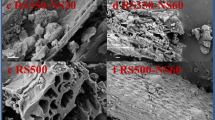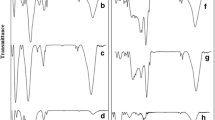Abstract
Purpose
To evaluate the adsorption capacity of aluminum-modified biochars for arsenate (As(V)) and the effect of the biochars on As(V) adsorption by acidic Ultisols.
Materials and methods
Rice straw was collected from Yingtan, Jiangxi Province. Rice straw and the biochar derived from rice straw were both treated with aluminum (Al) to prepare two kinds of Al-modified biochars. An Ultisol was collected from Jinxian, Jiangxi Province, and an indoor incubation was used to prepare biochar-ameliorated soil. Zeta potential and Fourier transform infrared spectroscopy (FTIR) were used to characterize the effects of Al modification on surface charge and functional groups of the biochars. The batch method was used to investigate the adsorption and desorption of As(V) by the biochars and the soil. Arsenic in equilibrium solution was determined using hydride generation–atomic fluorescence spectrometry.
Results and discussion
The yield of biochar derived from Al-treated rice straw was significantly greater than that of the biochar from untreated rice straw. The Al content of Al-treated biochar from rice straw was higher than that of biochar derived from Al-treated rice straw. Modification did not change the morphology of Al oxide on biochar. Zeta potential of the two modified biochars changed to a positive value compared with that of unmodified biochar, and more change in zeta potential was observed for the Al-treated biochar from rice straw than that of biochar derived from Al-treated rice straw. After As(V) was adsorbed by the two modified biochars, new absorption peaks were found in the FTIR spectra from the biochars at 892 cm−1 (biochar from Al-treated rice straw) and 884 cm−1 (Al-treated biochar from rice straw). The peaks suggested that a chemical bond was formed between As(V) and Al on biochars during As(V) adsorption. The two Al-modified biochars adsorbed much more As(V) than the unmodified biochar. The desorption of adsorbed As(V) in the modified biochars was very low, which indicated that specific adsorption was the dominant mechanism for As(V) adsorption. The addition of modified biochar promoted the adsorption of As(V) by the Ultisol. Moreover, Al-treated biochar from rice straw enhanced As(V) adsorption by the soil more than the biochar derived from Al-treated rice straw.
Conclusions
Compared with the effect of adding unmodified biochar, adding either of the two Al-modified biochars significantly enhanced the adsorption of As(V) by the Ultisol. Therefore, Al-modified biochar can be used to immobilize As(V) in arsenic-contaminated soils, especially in acidic soils.








Similar content being viewed by others
References
Anderson MA, Ferguson JF, Gavis J (1976) Arsenate adsorption on amorphous aluminum. J Colloid Interface Sci 54:391–399
Arai Y, Elzinga EJ, Sparks DL (2001) X-ray absorption spectroscopic investigation of arsenite and arsenate adsorption at the aluminum oxide-water interface. J Colloid Interface Sci 235:80–88
Beesley L, Marmiroli M (2011) The immobilisation and retention of soluble arsenic, cadmium and zinc by biochar. Environ Pollut 159:474–480
Beesley L, Moreno-Jiménez E, Gomez-Eyles JL, Harris E, Robinson B, Sizmur T (2011) A review of biochars’ potential role in the remediation, revegetation and restoration of contaminated soils. Environ Pollut 159:3269–3282
Bienert GP, Thorsen M, Schüssler MD, Nilsson HR, Wagner A, Tamás MJ, Jahn TP (2008) A subgroup of plant aquaporins facilitate the bi-directional diffusion of As(OH)3 and Sb(OH)3 across membranes. BMC Biol 6:26
Blanchard M, Morin G, Lazzeri M, Balan E, Dabo I (2012) First-principles simulation of arsenate adsorption on the (112) surface of hematite. Geochim Cosmochim Acta 86:182–195
Fendorf S, Eick MJ, Grossl P, Sparks DL (1997) Arsenate and chromate retention mechanisms on goethite. 1. Surface structure. Environ Sci Technol 31:315–320
Gray CW, Dunham SJ, Dennis PG, Zhao FJ, McGrath SP (1997) Field evaluation of in situ remediation of a heavy metal contaminated soil using lime and red-mud. Environ Pollut 142:530–539
Grossl PR, Eick M, Sparks DL, Goldberg S (1997) Arsenate and chromate retention mechanisms on goethite. 2. Kinetic evaluation using a pressure-jump relaxation technique. Environ Sci Technol 31:321–326
Guo H, Stüben D, Berner Z (2007) Removal of arsenic from aqueous solution by natural siderite and hematite. Appl Geochem 22:1039–1051
He SF, Liu CX, He YP, Shan Y, Xiong M, Luo YM (2011) Determination of Ca, Mg, Fe and Al in micro-silica by ICP-AES. Chin J Spectrosc Lab 28:822–825
Lebrun M, Miard F, Renouard S, Nandillon R, Scippa GS, Morabito D, Bourgerie S (2018) Effect of Fe-functionalized biochar on toxicity of a technosol contaminated by Pb and As: sorption and phytotoxicity tests. Environ Sci Pollut Res 25:33678–33690
Liu LN, Chen HS, Cai P, Liang W, Huang QY (2009) Immobilization and phytotoxicity of Cd in contaminated soil amended with chicken manure compost. J Hazard Mater 163:563–567
Liu ZG, Zhang FS, Sasai R (2010) Arsenate removal from water using Fe3O4-loaded activated carbon prepared from waste biomass. Chem Eng J 160:57–62
Liu X, Ao HY, Xiong X, Xiao JG, Liu JT (2011) Arsenic removal from water by iron-modified bamboo charcoal. Water Air Soil Pollut 223:1033–1044
Lloyd JR, Oremland RS (2006) Microbial transformations of arsenic in the environment: from soda lakes to aquifers. Element 2:85–90
Loehr RC, Webster MT (1996) Performance of long-term, field-scale bioremediation process. J Hazard Mater 50:105–128
Mamindy-Pajany Y, Hurel C, Marmier N, Roméo M (2011) Arsenic (V) adsorption from aqueous solution onto goethite, hematite, magnetite and zero-valent iron: effects of pH, concentration and reversibility. Desalination 281:93–99
Pan JJ, Jiang J, Xu RK (2013) Adsorption of Cr(III) from acidic solutions by crop straw derived biochars. J Environ Sci 25:1957–1965
Pan JJ, Jiang J, Xu RK (2014) Removal of Cr(VI) from aqueous solutions by Na2SO3/FeSO4 combined with peanut straw biochar. Chemosphere 101:71–76
Pan JJ, Jiang J, Qian W, Xu RK (2015) Arsenate adsorption from aqueous solution onto Fe(III)-modified crop straw biochars. Environ Eng Sci 32:922–929
Park JH, Choppala GK, Bolan NS, Chung JW, Chuasavathi T (2011) Biochar reduces the bioavailability and phytotoxicity of heavy metals. Plant Soil 348:439–451
Qian W, Zhao AZ, Xu RK (2013) Sorption of As(V) by aluminum-modified crop straw-derived biochars. Water Air Soil Pollut 224:1610
Querol X, Alastuey A, Moreno N, Alvarez-Ayuso E, García-Sánchez A, Cama J, Ayora C, Simón M (2006) Immobilization of heavy metals in polluted soils by the addition of zeolitic material synthesized from coal fly ash. Chemosphere 62:171–180
Tong XJ, Xu RK (2013) Removal of cu(II) from acidic electroplating effluent by biochars generated from crop straws. J Environ Sci 25:652–658
Tong XJ, Li JY, Yuan JH, Xu RK (2011) Adsorption of Cu(II) by biochars generated from three crop straws. Chem Eng J 172:828–834
Xu RK, Wang Y, Tiwari D, Wang HY (2009) Effect of ionic strength on adsorption of As(III) and As(V) by variable charge soils. J Environ Sci 21:927–932
Xu RK, Qafoku NP, van Ranst E, Li JY, Jiang J (2016) Adsorption properties of subtropical and tropical variable charge soils: implications from climate change and biochar amendment. Adv Agron 135:1–58
Yu TR (1997) Chemistry of variable charge soils. Oxford University Press, New York
Yuan C, Weng CH (2006) Electrokinetic enhancement removal of heavy metals from industrial wastewater sludge. Chemosphere 65:88–96
Yuan JH, Xu RK (2012) Effects of biochars generated from crop residues on chemical properties of acid soils from tropical and subtropical China. Soil Res 50:570–578
Yuan JH, Xu RK, Zhang H (2011a) The forms of alkalis in the biochar produced from crop residues at different temperatures. Bioresour Technol 102:3488–3497
Yuan JH, Xu RK, Qian W, Wang RH (2011b) Comparison of the ameliorating effects on an acidic Ultisol between four crop straws and their biochars. J Soils Sediments 11:741–750
Zhou R, Liu XC, Luo L, Zhou YY, Wei JH, Chen AW, Tang N, Wu HP, Deng YC, Zhang FF, Wang YY (2017) Remediation of Cu, Pb, Zn and Cd-contaminated agricultural soil using a combined red mud and compost amendment. Int Biodeterior Biodegradation 118:73–81
Funding
This study was supported by the National Natural Science Foundation of China (no. 41877036).
Author information
Authors and Affiliations
Corresponding author
Additional information
Responsible editor: Kitae Baek
Publisher’s note
Springer Nature remains neutral with regard to jurisdictional claims in published maps and institutional affiliations.
Rights and permissions
About this article
Cite this article
He, X., Jiang, J., Hong, Z. et al. Effect of aluminum modification of rice straw–based biochar on arsenate adsorption. J Soils Sediments 20, 3073–3082 (2020). https://doi.org/10.1007/s11368-020-02595-2
Received:
Accepted:
Published:
Issue Date:
DOI: https://doi.org/10.1007/s11368-020-02595-2




